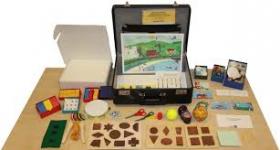
The Griffiths scales were originally designed to measure children from birth to two years.
During '60s these were extended to cover birth to eight years and, in order to perform this, a sixth scale (Practical Reasoning) was added to the five scales comprising the measure for the early years.
The timeline of revisions is the following:
- 1970, GMDS-E: first edition (extended for children 2-8 years old, 6 sub-scale)
- 1984, GMDS-ER: second edition (revision)
- 2006 Griffiths-III: third and most current edition (unification: unique scale for children 0-6 years old, 5 sub-scale)
The 6 six sub-scale
-
Locomotor: Gross motor skills including the ability to balance and to co-ordinate and control movements
-
Personal-Social: Proficiency in the activities of daily living, level of independence and interaction with other children
-
Language: Receptive and expressive language
-
Eye and Hand Co-ordination: Fine motor skills, manual dexterity and visual monitoring skills
-
Performance: Visuospatial skills including speed of working and precision
-
Practical Reasoning: ability to solve practical problems, understanding of basic mathematical concepts and understanding of moral issues.
Equipment
The items of the Griffiths scales should be administered using standard equipment, composed by 39 pieces.
Evaluation
- Item and Scoring: Administration Manual
- Score Interpretation: Analysis Manual
Raw scores are converted to four types of standard score:
- Percentiles (using look-up tables in the Analysis Manual or the graphs provided in the record books)
- Z-Scores (using look-up tables in the Analysis Manual)
- Age Equivalents or Mental Age (using look-up tables in the Analysis Manual)
- General Quotient or GQ (using look-up tables in the Analysis Manual).
References
